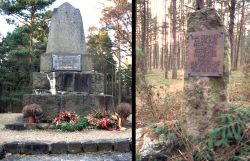
Battle of the Göhrde
Encyclopedia
The battle of the Göhrde was a battle of the War of the Sixth Coalition
on 18 September 1813 between Napoleonic and Coalition troops at Göhrde in Germany. The Napoleonic troops were defeated and withdrew to Hamburg
.
(Staatsforst Göhrde), near Dannenburg, near Lüneburg. At that time this area belonged to the electorate of Braunschweig-Lüneburg (Hanover
), which had been occupied by the French since 1803. The battlefield lies on the border between the modern-day districts of Lüneburg
and Lüchow-Dannenberg
, between Oldendorf an der Göhrde
and Göhrde
.
forced the French out of Hamburg and some northern areas of Hanover. In the wake of Prussia's reentry into the war against France, the eastern areas of Hanover also rose against Napoleon. Wallmoden then received overall command of all the Allied troops on the lower Elbe: troops from Prussia, Russia, the United Kingdom, Hanover, Hamburg, Mecklenburg and Sweden, including the Russian German legion, the Lützow Free Corps
, the Hanseatic Legion
and a part of the King's German Legion
, under the overall command of Generalleutnant Ludwig von Wallmoden-Gimborn
.
The Free Corps such as that from Lützow again and again attacked French supply lines and bases in the area around Mecklenburg
, south of the Elbe. The XIII Corps there, under marshal Davout, had up to this point behaved quite passively, restricting itself to holding Wallmoden's corps in check. As an anti-skirmishes measure, in September Davout sent general Pécheux
on the western Elbufer with a brigade of 50th infantry division and moved on Lüneburg with 3,000 troops. After completing his mission, Pécheux was ordered to rejoin the French troops in Magdeburg
. Wallmoden's corps advanced on Dömitz
on 15 September with 12,300 men, crossed the Elbe, marched toward the Frenchmen and set up camp in Dannenberg
.
's Hanoverian brigade managed to force the French troops to withdraw.
) and Napoleon's main army (then in Saxony
) and the Napoleonic armies' supply-lines across Hanover from France to Magdeburg and Berlin. This result was critical for the outcome of the Battle of Leipzig
soon afterwards.
 A large stone monument stands as a memorial to the battle in 1839, at a site now north of Bundesstraße 216 about 2 km behind Oldendorf in Richtung Dannenberg.
A large stone monument stands as a memorial to the battle in 1839, at a site now north of Bundesstraße 216 about 2 km behind Oldendorf in Richtung Dannenberg.
1000 dead soldiers from both sides were buried in a mass grave in the forest, 100m from where the memorial is sited. This grave was rediscovered in 1985.
Rudolf von Bennigsen
's father Karl von Bennigsen fought in this battle (as a lieutenant), as did the famous freedom fighter Eleonore Prochaska
. She had disguised herself as a man and joined the Lützow Free Corps
. During the battle she was wounded and soon afterwards succumbed to her injuries in the hospital at Dannenberg.
A reconstruction of the battle occurs every two years at Dahlenburg
. At the Heimatmuseum in the town a diorama of the battle is on permanent display, with 1500 tin soldiers.
War of the Sixth Coalition
In the War of the Sixth Coalition , a coalition of Austria, Prussia, Russia, the United Kingdom, Portugal, Sweden, Spain and a number of German States finally defeated France and drove Napoleon Bonaparte into exile on Elba. After Napoleon's disastrous invasion of Russia, the continental powers...
on 18 September 1813 between Napoleonic and Coalition troops at Göhrde in Germany. The Napoleonic troops were defeated and withdrew to Hamburg
Hamburg
-History:The first historic name for the city was, according to Claudius Ptolemy's reports, Treva.But the city takes its modern name, Hamburg, from the first permanent building on the site, a castle whose construction was ordered by the Emperor Charlemagne in AD 808...
.
Site
It occurred near what is now the site of the Göhrde State ForestGöhrde State Forest
The Göhrde State Forest is the largest contiguous mixed forest region in North Germany. It lies in the districts of Lüchow-Dannenberg and Lüneburg.- Description :...
(Staatsforst Göhrde), near Dannenburg, near Lüneburg. At that time this area belonged to the electorate of Braunschweig-Lüneburg (Hanover
Electorate of Hanover
The Electorate of Brunswick-Lüneburg was the ninth Electorate of the Holy Roman Empire of the German Nation...
), which had been occupied by the French since 1803. The battlefield lies on the border between the modern-day districts of Lüneburg
Lüneburg (district)
Lüneburg is a district in Lower Saxony, Germany. It is bounded by the districts of Lüchow-Dannenberg, Uelzen, Heidekreis and Harburg, and the states of Schleswig-Holstein and Mecklenburg-Western Pomerania .-History:The Amt of Lüneburg appeared in 1862...
and Lüchow-Dannenberg
Lüchow-Dannenberg
Lüchow-Dannenberg is a district in Lower Saxony, Germany which is usually referred to as Hannoversches Wendland or Wendland. It is bounded by the districts of Uelzen and Lüneburg and the states of Mecklenburg-Western Pomerania , Brandenburg and Saxony-Anhalt Lüchow-Dannenberg is a district in...
, between Oldendorf an der Göhrde
Nahrendorf
Nahrendorf is a municipality in the district of Lüneburg, in Lower Saxony, Germany....
and Göhrde
Göhrde
Göhrde is a municipality in the district of Lüchow-Dannenberg, in Lower Saxony, Germany.The municipality was named after the Göhrde State Forest, which has an area of about , famous for its oaks, beeches and game preserves. The hunting lodge situated in the forest was built in 1689 and was restored...
.
Context
In spring 1813, Russian troops under Friedrich Karl von TettenbornFriedrich Karl von Tettenborn
Baron Friedrich Karl of Tettenborn was a famous cavalry general in the Austrian and Russian armies during the Napoleonic Wars.-Life:...
forced the French out of Hamburg and some northern areas of Hanover. In the wake of Prussia's reentry into the war against France, the eastern areas of Hanover also rose against Napoleon. Wallmoden then received overall command of all the Allied troops on the lower Elbe: troops from Prussia, Russia, the United Kingdom, Hanover, Hamburg, Mecklenburg and Sweden, including the Russian German legion, the Lützow Free Corps
Lützow Free Corps
Lützow Free Corps was a voluntary force of the Prussian army during the Napoleonic Wars. It was named after its commander, Ludwig Adolf Wilhelm von Lützow. They were also widely known as "Lützower Jäger" or "Schwarze Jäger" .-Origins:...
, the Hanseatic Legion
Hanseatic Legion
The Hanseatic Legion was a military unit, first formed of a group of citizens of Hamburg. They had met in 1813 on the instigation of General Friedrich Karl von Tettenborn, in order to fight in the War of the Sixth Coalition...
and a part of the King's German Legion
King's German Legion
The King's German Legion was a British Army unit of expatriate German personnel, 1803–16. The Legion achieved the distinction of being the only German force to fight without interruption against the French during the Napoleonic Wars....
, under the overall command of Generalleutnant Ludwig von Wallmoden-Gimborn
Ludwig von Wallmoden-Gimborn
Ludwig Georg Thedel, Graf von Wallmoden was an Austrian "General of the Cavalry", best known for his training of light infantry and the refinement of the Tirailleur system.-Life:...
.
The Free Corps such as that from Lützow again and again attacked French supply lines and bases in the area around Mecklenburg
Mecklenburg
Mecklenburg is a historical region in northern Germany comprising the western and larger part of the federal-state Mecklenburg-Vorpommern...
, south of the Elbe. The XIII Corps there, under marshal Davout, had up to this point behaved quite passively, restricting itself to holding Wallmoden's corps in check. As an anti-skirmishes measure, in September Davout sent general Pécheux
Marc Nicolas Louis Pécheux
Marc Nicolas Louis Pécheux was a French general during the Napoleonic Wars....
on the western Elbufer with a brigade of 50th infantry division and moved on Lüneburg with 3,000 troops. After completing his mission, Pécheux was ordered to rejoin the French troops in Magdeburg
Magdeburg
Magdeburg , is the largest city and the capital city of the Bundesland of Saxony-Anhalt, Germany. Magdeburg is situated on the Elbe River and was one of the most important medieval cities of Europe....
. Wallmoden's corps advanced on Dömitz
Dömitz
Dömitz is a municipality in the Ludwigslust-Parchim district, in Mecklenburg-Western Pomerania, Germany. It is situated on the right bank of the Elbe, 25 km southwest of Ludwigslust, and 37 km northwest of Wittenberge....
on 15 September with 12,300 men, crossed the Elbe, marched toward the Frenchmen and set up camp in Dannenberg
Dannenberg
- Places :* Dannenberg , a town in Germany* County of Dannenberg, a medieval fief founded by Henry the Lion- People :* Konrad Dannenberg, German-American engineer* Peter A Dannenberg, Russian general...
.
Course
The French division under Pechaux decided to attack the allies. On the early afternoon of 18 September 1813, it reached the Steinker Höhen (Steinker Heights) in Nahrendorf and gave battle. Wallmoden's units arrived one after the other and attacked the poorly-coordinated French force, though these single attacks were all repulsed until in the evening Hugh HalkettHugh Halkett
General Baron Hugh Halkett, GCH, CB, was a British soldier during the Napoleonic Wars and later a general of infantry in the Hanoverian service.-Early career:...
's Hanoverian brigade managed to force the French troops to withdraw.
Results
The battle was the first victory over the French troops garrisoning Germany, and interrupted the link between XIII Corps under general Davout (with its headquarters in HamburgHamburg
-History:The first historic name for the city was, according to Claudius Ptolemy's reports, Treva.But the city takes its modern name, Hamburg, from the first permanent building on the site, a castle whose construction was ordered by the Emperor Charlemagne in AD 808...
) and Napoleon's main army (then in Saxony
Saxony
The Free State of Saxony is a landlocked state of Germany, contingent with Brandenburg, Saxony Anhalt, Thuringia, Bavaria, the Czech Republic and Poland. It is the tenth-largest German state in area, with of Germany's sixteen states....
) and the Napoleonic armies' supply-lines across Hanover from France to Magdeburg and Berlin. This result was critical for the outcome of the Battle of Leipzig
Battle of Leipzig
The Battle of Leipzig or Battle of the Nations, on 16–19 October 1813, was fought by the coalition armies of Russia, Prussia, Austria and Sweden against the French army of Napoleon. Napoleon's army also contained Polish and Italian troops as well as Germans from the Confederation of the Rhine...
soon afterwards.
Commemorations

1000 dead soldiers from both sides were buried in a mass grave in the forest, 100m from where the memorial is sited. This grave was rediscovered in 1985.
Rudolf von Bennigsen
Rudolf von Bennigsen
Rudolf von Bennigsen was a German politician descended from an old Hanoverian family. His father, Karl von Bennigsen, was an officer in the Hanoverian army who rose to the rank of general and also held diplomatic appointments...
's father Karl von Bennigsen fought in this battle (as a lieutenant), as did the famous freedom fighter Eleonore Prochaska
Eleonore Prochaska
Eleonore Prochaska was a German woman soldier who fought in the Prussian army against Napoleon during the War of the Sixth Coalition.-Life:...
. She had disguised herself as a man and joined the Lützow Free Corps
Lützow Free Corps
Lützow Free Corps was a voluntary force of the Prussian army during the Napoleonic Wars. It was named after its commander, Ludwig Adolf Wilhelm von Lützow. They were also widely known as "Lützower Jäger" or "Schwarze Jäger" .-Origins:...
. During the battle she was wounded and soon afterwards succumbed to her injuries in the hospital at Dannenberg.
A reconstruction of the battle occurs every two years at Dahlenburg
Dahlenburg
Dahlenburg is a municipality in the district of Lüneburg, in Lower Saxony, Germany. It is situated approx. 25 km east of Lüneburg. Dahlenburg has a population of 3,449 ....
. At the Heimatmuseum in the town a diorama of the battle is on permanent display, with 1500 tin soldiers.

